In the previous chapter, we’ve discussed the paradigm and concepts of OpenPGP CA at a high level.
Now, we’ll take a more detailed, technical look at the relevant OpenPGP mechanisms, as well as the OpenPGP CA software itself.
The OpenPGP CA software
- OpenPGP CA is a suite of software, written in Rust.
- It uses Sequoia PGP.
- All code is Free Software under the GPLv3.
- The CA’s private key can be used via different mechanisms:
- directly as a “softkey” (the private key material is stored in the CA database and accessible to the computer that OpenPGP CA runs on), or
- using an OpenPGP card device (this protects the CA key from exfiltration, and even from use by attackers, depending on the configuration).
- The architecture follows a “library first” approach:
- The main variant of OpenPGP CA is a CLI tool, designed for use by a CA admin.
- The functionality can also be integrated into existing systems as a REST service.
- All state is persisted in a single file (using an SQLite database).
- This makes it easy to reason about backups and to keep the CA database safe1.
Authentication and the OpenPGP web of trust
The OpenPGP standard provides a powerful mechanism to authenticate keys: the “web of trust”2.
The web of trust mechanism reasons about authentication on behalf of the user, based on certifications. A certification is a machine-readable vouch, which asserts that an identity (a person, a machine, or an organization) controls some key3, or (partially) delegates authentication decisions to another party.
These certifications can be exchanged between OpenPGP implementations and users, and are typically included when distributing OpenPGP keys.
Regular certifications
Let’s first look at a regular certification. Here, Bob certifies the identity
carol@example.org on Carol’s key (after checking that the key is indeed
controlled by Carol):
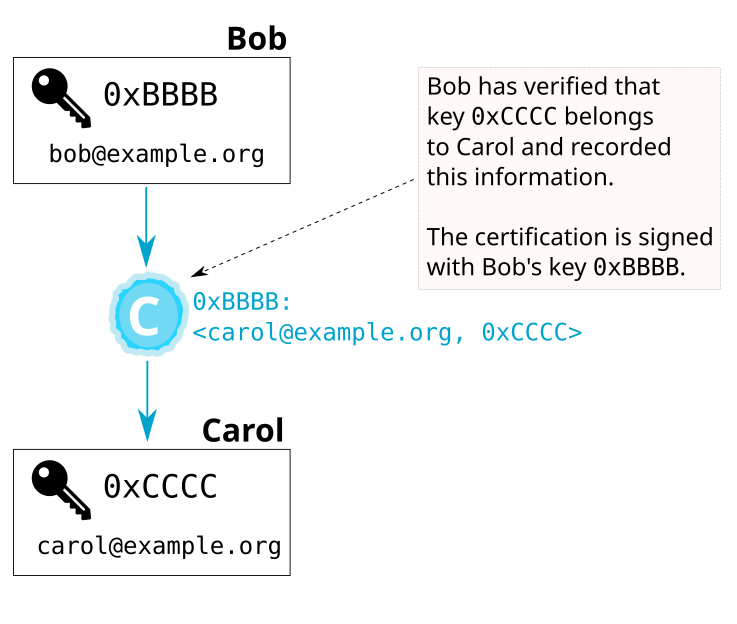
Specifically, Bob asserts that Carol (or, more precisely: Carol’s identity
carol@example.org) controls the key 0xCCCC4.
And, he has created a certification that records that assertion.
Bob’s certification binds the identity carol@example.org with
the key 0xCCCC.
This certification is first useful to Bob: his software now understands that he has verified Carol’s key. However, if he publishes the certification, e.g., on a key server, it can also be useful to others.
Manually reasoning about certifications
Let’s imagine that Alice wants to communicate with Carol,
but she hasn’t authenticated Carol’s key yet.
If Alice has access to Bob’s certification, it serves as evidence that
0xCCCC is the right key for Carol:
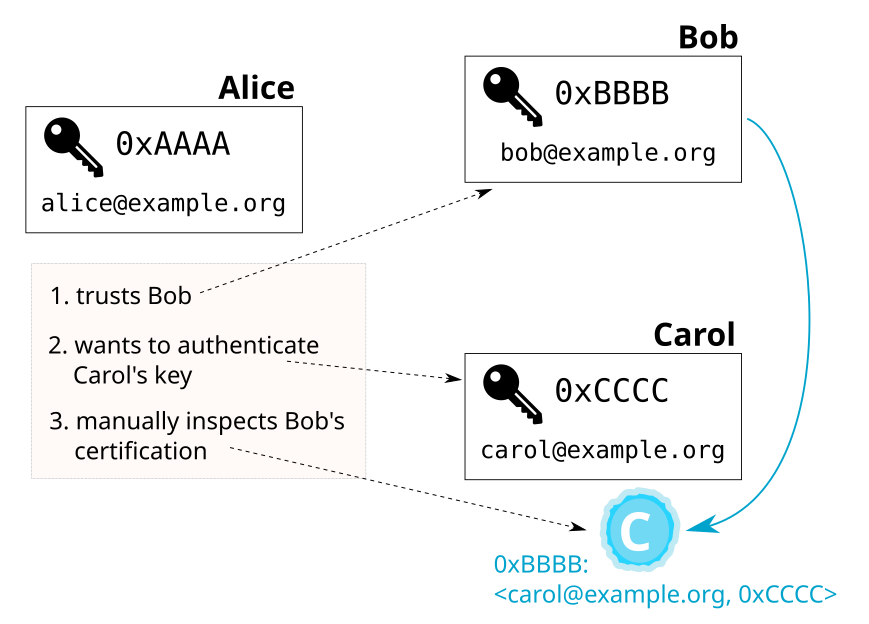
Of course, Alice should only trust Bob’s certification as much as she trusts Bob to correctly certify Carol’s key.
Certifications and delegation
The mechanisms that make up OpenPGP’s web of trust are extremely powerful.
Besides certifying that an identity controls a key (like: carol@example.org
controls key 0xCCCC), it is possible to designate a key as a
trusted introducer, i.e., a certificate authority (CA)5.
In OpenPGP terms, this is done using a type of certification called a “trust signature” (sometimes abbreviated as tsig)6.
Continuing the example from above, instead of manually reasoning about Bob’s certification, Alice can designate Bob as a trusted introducer. This way, Alice delegates (some) authentication decisions to Bob.

This delegation signals to Alice’s OpenPGP software that she wants it to rely on Bob’s certifications as if she had made those same certifications herself.
Limiting delegation of authentication decisions
OpenPGP’s delegation mechanism provides nuance. It is possible to limit the scope of trust using regular expressions over the User ID.
For instance, Alice may trust Dave from the NSA to certify users within his own organization, but not other people.
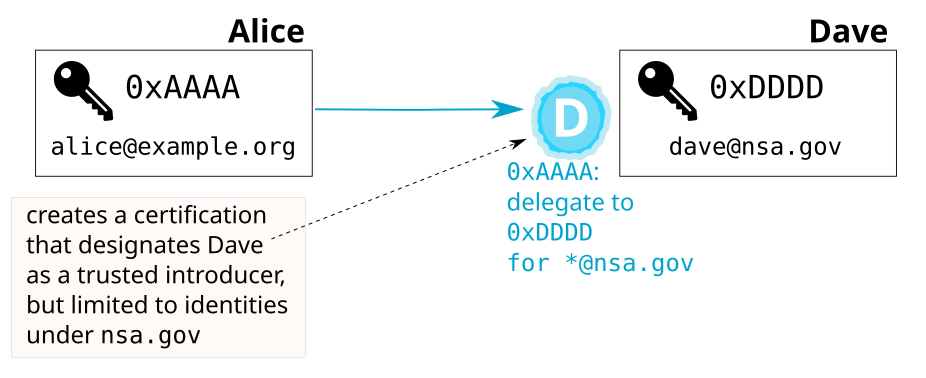
Combined effect of certifications
Now let’s see how two of the certifications we introduced above interact:
Alice has designated Bob as a trusted introducer, and Bob has
certified the binding between Carol’s key 0xCCCC and Carol’s identity
carol@example.org.
Based on these two certifications, Alice’s OpenPGP software automatically
determines that Carol’s key and her identity are legitimately connected.
It considers Carol’s key authenticated:

This is an example of how the web of trust mechanism operates: it reasons about a set of keys and certifications, and determines if the certifications show that a key (in this example: Carol’s) is considered authentic.
OpenPGP CA uses the web of trust
Our approach to authentication is built using the existing and well-established OpenPGP “web of trust” mechanisms. Because these mechanisms are part of the OpenPGP specification, all OpenPGP implementations understand them. Thus, OpenPGP CA works out of the box with existing OpenPGP implementations, such as GnuPG.
OpenPGP CA makes it easy for organizations to leverage the power of the OpenPGP web of trust, by moving the burden of authentication away from users (and to the new role of the in-house CA admin).
Authentication within an organization
With OpenPGP CA, the CA certifies the keys of each user in the organization using regular OpenPGP certifications. To take advantage of these certifications, users in the organization need to delegate authentication decisions to their organization’s CA. In OpenPGP terms, users generate a trust signature for the CA’s key.
In short, each user normally certifies the CA’s key, and the CA certifies each user’s key (the CA asserts that it has verified the link between the user’s email identity and their key).
Consider, for instance, Alice whose email address is alice@example.org:
- The CA key certifies the
alice@example.orgUser ID on Alice’s key. This certification means that the CA has verified that the key is indeed controlled by Alice.
As a consequence of this certification, anyone who usesopenpgp-ca@example.orgas a trusted introducer has an authenticated path to Alice’s key. - Alice designates
openpgp-ca@example.orgas a trusted introducer. This delegation means that Alice trusts certifications that the CA key makes on other keys; Alice trusts the CA to authenticate third parties on her behalf.
The following figure shows the keys and certifications in an OpenPGP CA-using organization with two users, Alice and Bob.
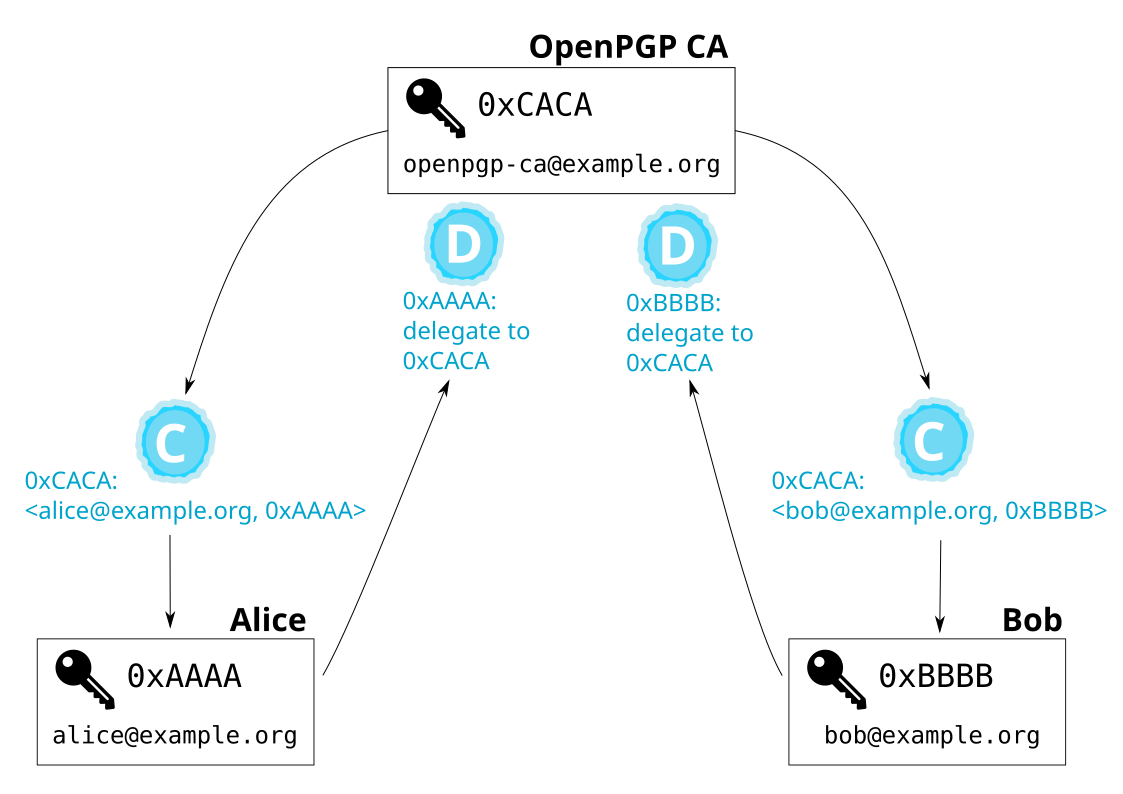
The mutual certifications between each user and the CA mean that all members of the organization have a verified path to each other. And this remains the case even as new members join the organization: users don’t need to take any special action to authenticate new colleagues (or new keys for existing colleagues), only the CA admin does.
For example, if Alice wants to authenticate Bob, her OpenPGP software will use two certifications to do the authentication: the delegation Alice made to the CA’s key, and the certification that the CA made on Bob’s key. The next figure illustrates how Alice’s software automatically authenticates Bob’s key:
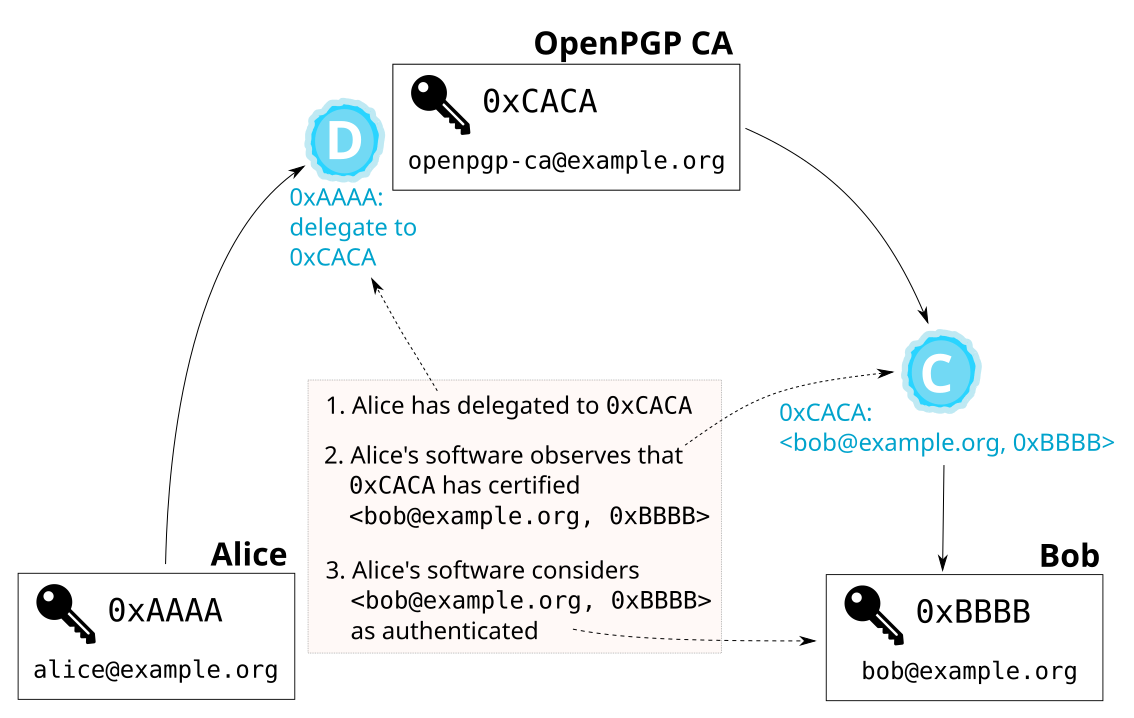
Authentication between organizations: Bridges
Organizations often work closely with a few other organizations. It greatly simplifies secure communication when users have automatic authenticated access to keys of colleagues in sister organizations.
As above, our goal is secure communication, without manual overhead. OpenPGP CA supports this use case by facilitating the creation of so-called bridges between organizations.
In technical terms, OpenPGP CA bridges organizations using scoped trust signatures.
For instance, if users at the two organizations alpha.example and beta.example
communicate with each other on a regular basis, then the two OpenPGP CA
administrators can exchange fingerprints, and create a trust
signature over each other’s domain. These trust signatures are usually scoped to the domain of the
respective remote organization. The reason for this is that the CA admin of
alpha.example probably only wants the CA at beta.example to act as a
trusted introducer for users at beta.example, but not for keys outside that
namespace (allowing the remote CA admin to act as a trusted introducer for
arbitrary User IDs gives the remote CA admin too much power, in most
contexts).
Using a bridge, members of each organization can authenticate members of the remote organization. The following figure shows the keys and certifications that are created when bridging two organizations.

The bold path shows how Alice’s OpenPGP software can authenticate Bob.
Gateways into organizations
Because users use a trust signature to certify the OpenPGP CA’s key, anyone who considers someone at an OpenPGP CA-using organization to be a trusted introducer can also automatically authenticate everyone else in the organization.
Emergent Properties
Many individual users of OpenPGP don’t currently use trusted introducers.
But that doesn’t mean that their tools can’t make use of such certifications.
Consider the following scenario.
Alice and Bob are from example.org, which uses OpenPGP
CA. And Zed, an individual who is not part of an organization that uses
OpenPGP CA, regularly communicates with Alice. Now, let’s say that Zed
wants to send Bob an email. Zed might find many keys that claim to be
Bob’s. Some might be keys that Bob has lost control of and hasn’t revoked.
Others may have been published by an attacker. What key should he use for
Bob?
Because we use standard OpenPGP artifacts - in particular trust signatures - we can publish them. Then, using the normal web of trust mechanisms, Zed’s tools can detect a reasonable key for Bob based on two observations. First, the tool can observe that there is a verified path from Alice to Bob’s current key in the web of trust. Second, since Zed is able to successfully communicate with Alice, there is a good chance that he has the correct key for her. Thus, we have a likely reasonable candidate key for Bob even if it is not strongly authenticated.
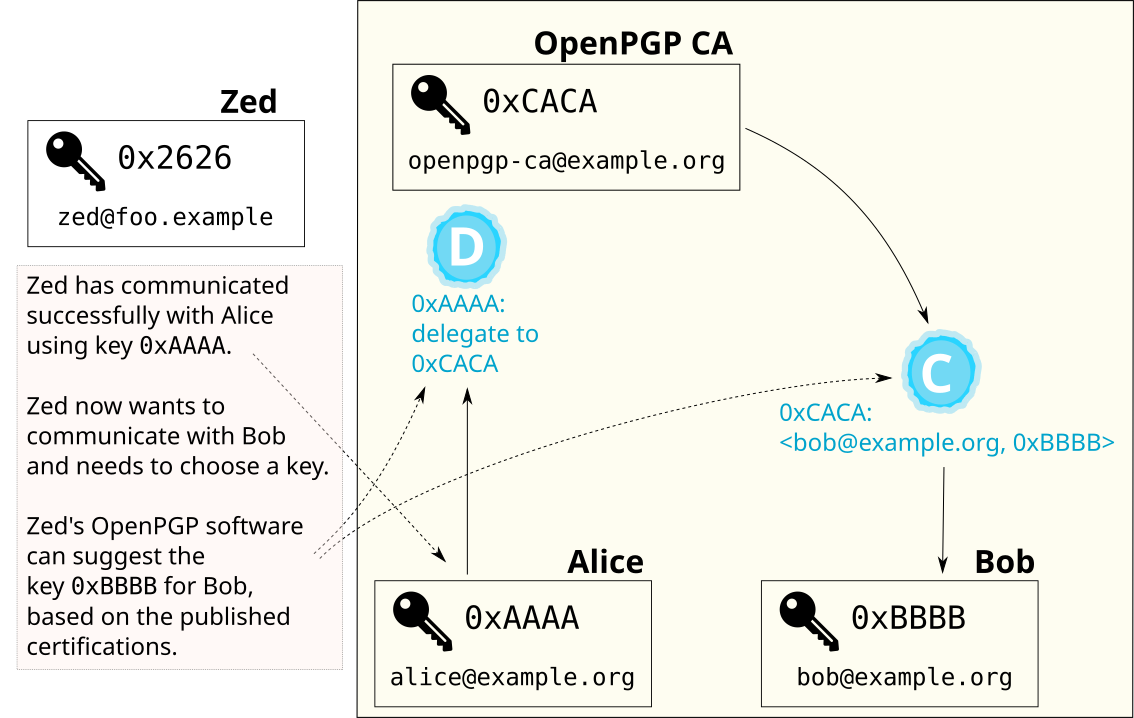
This approach is just a heuristic. But, it is a good heuristic when strong authentication is not required. It avoids the frustrating and debilitating scenario in which Zed uses the wrong key and Bob can’t decrypt his message.
User key setup for OpenPGP CA
There are two different ways in which user keys may be set up in an organization that uses OpenPGP CA: decentralized and centralized user key creation.
In both cases, the CA admin makes sure that a structure of certifications exists between keys in the organization.
Decentralized user key creation
“Decentralized key creation” is the default approach:
Users create their own keys, on their own devices.
After a user has created a new key, they send their new public key to the CA admin, who, after authenticating it, adds it to the CA database (the CA software automatically generates certifications for the identities that the admin has authenticated).
To get all the benefits of OpenPGP CA, the user also needs to certify the CA’s key (to delegate authentication decisions to the CA). This is a non-trivial task, with today’s tooling7. But it only needs to be done once per user, as initial setup. And with help from the CA admin or a help desk team, this is doable.
Centralized user key creation
An alternative workflow is that user keys are (centrally) created by the OpenPGP CA admin. In this workflow - because OpenPGP CA creates the user’s key - OpenPGP CA can automatically generate all required certifications.
During creation of the user key, OpenPGP CA only keeps the private key material in RAM and never saves it to disk. Still, this method is more risky than decentralized user key creation.
Revocation Certificates
During centralized key creation, OpenPGP CA optionally generates and stores several revocation certificates8 for users9.
This allows the CA operator to revoke user keys when users lose access to them, or when users leave the organization.
Setup workflows on the user side
Decentralized workflow
In most contexts, it is preferable to generate user keys on the user’s own machine. This way, the user has sole control over the private key material.
However, with currently available tooling, decentrally setting up users keys for use with OpenPGP CA is a multi-step process that may require some guidance:
- The user obtains and authenticates the CA’s public key,
- The user generates their own new key,
- and generates a certification (trust signature) for the CA’s key.
- This certification and the user’s public key are transferred to the CA admin.
The CA admin then authenticates and imports this new user key into OpenPGP CA (which automatically certifies the specified User IDs of the user’s key).
Centralized workflow
Alternatively, with OpenPGP CA, the CA admin can provision a user with a key. In addition to generating the key, OpenPGP CA creates certifications between the new user key and the CA’s key. The admin sends the private key (including a certification for the CA key) to the user10. This can be done by saving it on a USB drive, or sending it by email (encrypted with a strong password).
The user then imports their new private key and sets it to be “ultimately” trusted (i.e., they tell their OpenPGP implementation that this is their own key), and they import the CA’s public key.
Following this, the user has an OpenPGP setup where their OpenPGP software can automatically find the keys for their coworkers (via WKD) and strongly authenticate those keys. The users don’t need to compare fingerprints, they don’t need to go to a key signing party, in fact, they don’t even need to understand what a certification is.
The OpenPGP CA tool from the admin’s perspective
OpenPGP CA as a tool for the CA admin operates on a database that contains a number of artifacts:
-
It is a central repository of all public OpenPGP keys of the users in the organization.
-
It also contains certifications between the users and the CA admin.
-
Further, OpenPGP CA’s database optionally contains revocation certificates for user keys.
-
Finally, the CA’s private OpenPGP key is in the database, if the CA is operated in “software key”-mode11. The private key is used to generate the certifications by the CA, and as such needs to be kept safe.
Currently, OpenPGP CA can export OpenPGP keys, create a WKD and GPG Sync-style Keylists. The admin needs to publish these manually12.
-
Depending on details of how the instance is set up, the CA database is often very security critical. ↩︎
-
See the
sequoia-wotproject for a detailed specification of the web of trust mechanism. ↩︎ -
This type of certification is also called “third-party certification” (in contrast to “self-signatures”, which are used within OpenPGP certificates, e.g. to bind User IDs to one’s certificate).
Colloquially, third-party certifications are sometimes referred to simply as “signatures” (as in: “Bob signed Carol’s key”). ↩︎
-
We’re using identifiers like
0xCCCCin this document as a way to reference a specific OpenPGP key. The string0xCCCCis intended as shorthand for the key’s OpenPGP fingerprint. Actual, unabbreviated, OpenPGP fingerprints look like:34F9E4B6A0A70BFEC5AE45198356989DF1977575. (They are sometimes prefixed with0x. We use this notation here to make “identifiers of keys” easy to distinguish from other identity markers) ↩︎ -
Popular implementations of OpenPGP currently only support trust signatures that combine certifying the binding between an identity and a key with delegation of authentication to that key.
In this text, we ignore the certification aspect of those trust signatures because it is not relevant in our current context. Alice’s trust signature in practice does two things: it certifies the binding
<bob@example.org, 0xBBBB>and it delegates authentication decisions to0xBBBB. ↩︎ -
With GnuPG, it’s possible to get similar semantics to trust signatures by setting the ownertrust property for keys. When using GnuPG, if a user were to set this ownertrust property on the OpenPGP CA key to the value ‘Fully’, their setup would work as expected.
However, OpenPGP CA strongly prefers the use of trust signatures to designate the OpenPGP CA key as trusted. Trust signatures are specified in the OpenPGP standard, and as a standardized OpenPGP concept, they work the same with all OpenPGP implementations. ↩︎
-
In upcoming versions of OpenPGP CA, we will add tooling to make the user side of this workflow much easier. ↩︎
-
The reason to create multiple revocations is so that at a later time, the most appropriate revocation reason can be used. e.g., key lost, key compromised, etc. ↩︎
-
In theory, we could simply have users set the CA key as a designated revoker, but there isn’t much support for designated revokers in the OpenPGP ecosystem. ↩︎
-
Additionally, the user’s public key is optionally published in the organization’s WKD, and uploaded to key servers. ↩︎
-
When using the OpenPGP card backend, the CA’s private key is not stored in the CA database, but resides on the hardware device. Using a hardware-backed CA key makes it easier to keep the CA private key material safe. ↩︎
-
For an upcoming version of OpenPGP CA, we plan to add support to more easily publish user’s public keys on key servers and via other distribution mechanisms. ↩︎
